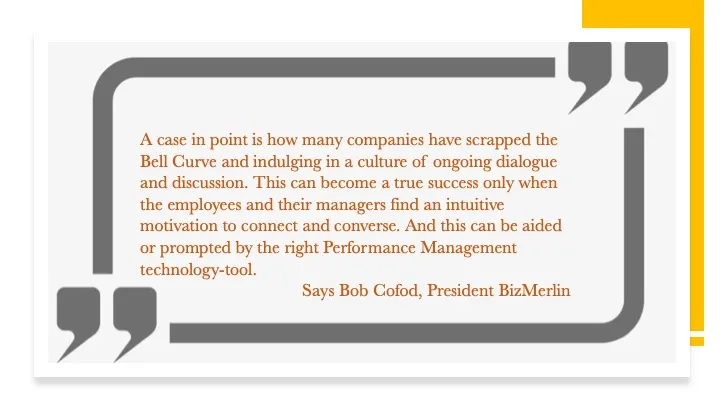ClayHR calificado como "Mejor software de recursos humanos para organizaciones globales de tamaño mediano".
Organizational performance is a high-focus area for leaders and HR alike, considering that we are navigating highly uncertain and dynamic business environments. Employee performance management translates to organizational performance, and so enhancing employee performance is one of HR’s key concerns.
Lately, we have seen a slew of “best practices” in the performance management space- many organizations are shifting away from the traditional performance management constructs and modernizing the process, either by implementing an entirely new model of “check-ins”, or by implementing new technological systems. Either way, much of this change is being driven by new technologies.
Technology is in fact, proving to be a true game-changer when it comes to managing performance, it allows HR to implement best practices, incorporate personalized experiences, and also bring about standardization based on the important tenets of fairness and trust.
RELATED ARTICLE: GUIDE TO AGILE PERFORMANCE REVIEWS
Technology has pervaded our lives like never before. Employees are used to engaging with technology for their personal tasks, be it conversing with someone or ordering groceries online. These advanced technology-led services are available at the tap of a digital device, and hence people are fast becoming accustomed to a high degree of convenience and comfort that traditional approaches cannot offer. These are the very people who work in today’s organizations, and hence they expect a similar degree of comfort and convenience when it comes to organizational processes.
Specifically, the performance management process directly impacts a person’s career advancement and professional growth, and therefore employees expect absolute fairness and transparency in the performance management process. Traditional performance reviews were highly influenced by human judgment, allowing various types of biases like recency bias, confirmation bias, etc. to creep into performance evaluation. This has resulted in many professionals looking askance at performance management, questioning the effectiveness of the process from a view of authentically evaluating human performance.
The redesign of performance management is picking up speed: 79 percent of executives rate it a high priority, up from 71 percent three years ago, with 38 percent calling the problem “very important” 2017 Global Human Capital Trends, Deloitte
Now, with a fundamental change in the ways of working, careers and learning are taking on renewed importance, and companies and people have long shifted from mere “jobs” to “work” and “careers”. Continuous learning is no longer a good-to-have, it is a must-have to sustain in an ever-changing world.
Constant change means more need to align employees’ values to the organizational values, so as to get the desired productivity and work effectiveness. Another angle that adds up to this need is the nature of employees themselves- today’s employees want to have a voice. They want more continuous feedback, want to continuously learn and grow in their careers, and want to take on leadership challenges early-on.
How then do organizations meet these ever-increasing employee expectations, while staying on track on the organizational strategic direction? The answer lies in investing in the right HRM software for performance management. The end objective should be to make work and life more value-adding for people and equip them to be their best selves.
Contrary to popular perception, technologizing performance management is not merely about having a performance management tool in place. It is about ingraining technology-led performance processes as a way of life.
The design and experience of a Performance Management Software should start with an alignment of the individual and team vision, mission, and values with the organizational values. It should be in line with the modern ways of working, i.e., team effectiveness, collaboration, ongoing communication, continuous feedback, break-down of siloed functioning, employee development etc.

HR must, therefore, look at the latest emerging technologies to revolutionize the fundamental Performance Management philosophy from a rigid, traditional approach to a contemporary, employee-empowering approach. Machine learning, data, and analytics, social sharing, cloud computing are some of the emerging technologies that HR should weave into Performance Management tools.
From throwing the right learning recommendations to excel in one’s role, to helping managers accurately identify high potentials by using qualitative and quantitative insights, the opportunities are immense.
Both ends of the spectrum i.e. organizations and employees stand to benefit immensely from the technologization of performance management processes.
These are just some of the many advantages of digging talent technologies in the Performance Management Space. A number of statistics prove that organizations and leaders are mostly in favor of revamping performance management the technology way. It is not a question of “if”, but “when”.
Only 34% of leaders believe the current performance management approaches are highly effective at helping employees rapidly adapt to change Accenture Strategy
While many business and HR leaders may be convinced about the dire need to technologize performance management, questions still abound on the readiness of the HR organization to instate this change. No change is pleasant, teething challenges and mindset resistance make it difficult to implement and sustain for the better. Many companies which have done away with the forced ranking system of Performance Management Software, have not entirely scrapped it.
Many have retained some measurements, maybe making them a tad more qualitative, intuitive and future-relevant than the rigid ones. Leave alone implementing cutting-edge technologies like machine learning, most organizations are still trying to figure out the first step i.e. getting their data ready and mature.
Managing people’s performance comes with its own sensitivities and nuances. Leaders must understand these, and assure their people that this change is for the better. Only then will people adopt and embrace the new processes and systems as a way of organizational life. And that too will take time and constant effort from the leadership and HR.
88 percent of companies took two years to gain significant traction with a new Performance Management system The NeuroLeadership Institute

The real question that needs to be asked is not whether performance management is ready for a technology makeover, but whether the organizational processes, infrastructure and most importantly the people are ready for a technology makeover?
Of course, technologizing performance management does not mean that you are totally removing the human element. On the contrary it is about segregating the mundane from the enriching, so as to provide people a great experience. It is a well-known fact that managing people cannot be reduced to man-machine interactions, and that is not even the intent of marrying technology with performance management.
Technology offers us the opportunity to do exactly the opposite- enhance the quality of human interactions. HR professionals should therefore constantly assess the impact of PM technology, and keep the following key things in mind while doing so:
The “how” of bringing about a performance management makeover is often more important than the “what”.
Every leader knows about the latest hot technologies that are helping build the so-called “best practices in Performance Management”. But what they may not know is whether all these technologies are actually relevant and needed for their organization.
The “how” is thus all about not succumbing to the temptation of blinding instating cloud, social, people analytics, etc., or getting into a rush to implement it all and appear “cool”. It is about having a thoughtful a selective approach of what is the true objective to technologize the Performance Management process.
For that, HR leaders must first define the objective. Here is what HR leaders and business leaders should dwell upon to master the “how” of performance management tech transformation.
Define the objective: Leaders must clearly outline what they will achieve by technologizing performance management. Is it better efficiencies? Or do they wish to build a more collaborative culture? Or do they want better-engaged employees? Decide on the core primary objective/s and build the system and process centered on it.
Partner with the right software provider: To cash in upon the sudden craze for Performance Management software, a number of enabling vendors and partners have mushroomed in the market. It is important to select the right partner in this technological transformation journey. This means ensuring the right capabilities, the same vision, common outcomes, acceptable (and not acceptable) ways of working, and terms of support and ongoing association. It is about deep diving into the minute features, because this can greatly alter the user experience.
For example, at ClayHR, the Performance Review application is all about focusing on what really matters i.e. keeping employees happy and growing. Here is a look at the key features that have made this possible:
These features, along with automated notifications and emails make the Performance Management process a breeze for managers and employees alike.
Yes, the performance management revolution is here to stay for a while. Organizations are experimenting with new constructs, technologies, and tools to realize the maximum potential of their people. This is going to be an ongoing process, but it is time that organizations take the first step towards befriending technology and use it to enable and empower their people to be their best.
As mentioned in the following SHRM blog by Dan Rockwell, if you want to change people, change what they believe about themselves. Perhaps this change in today’s technology-led age starts with changing technology itself.